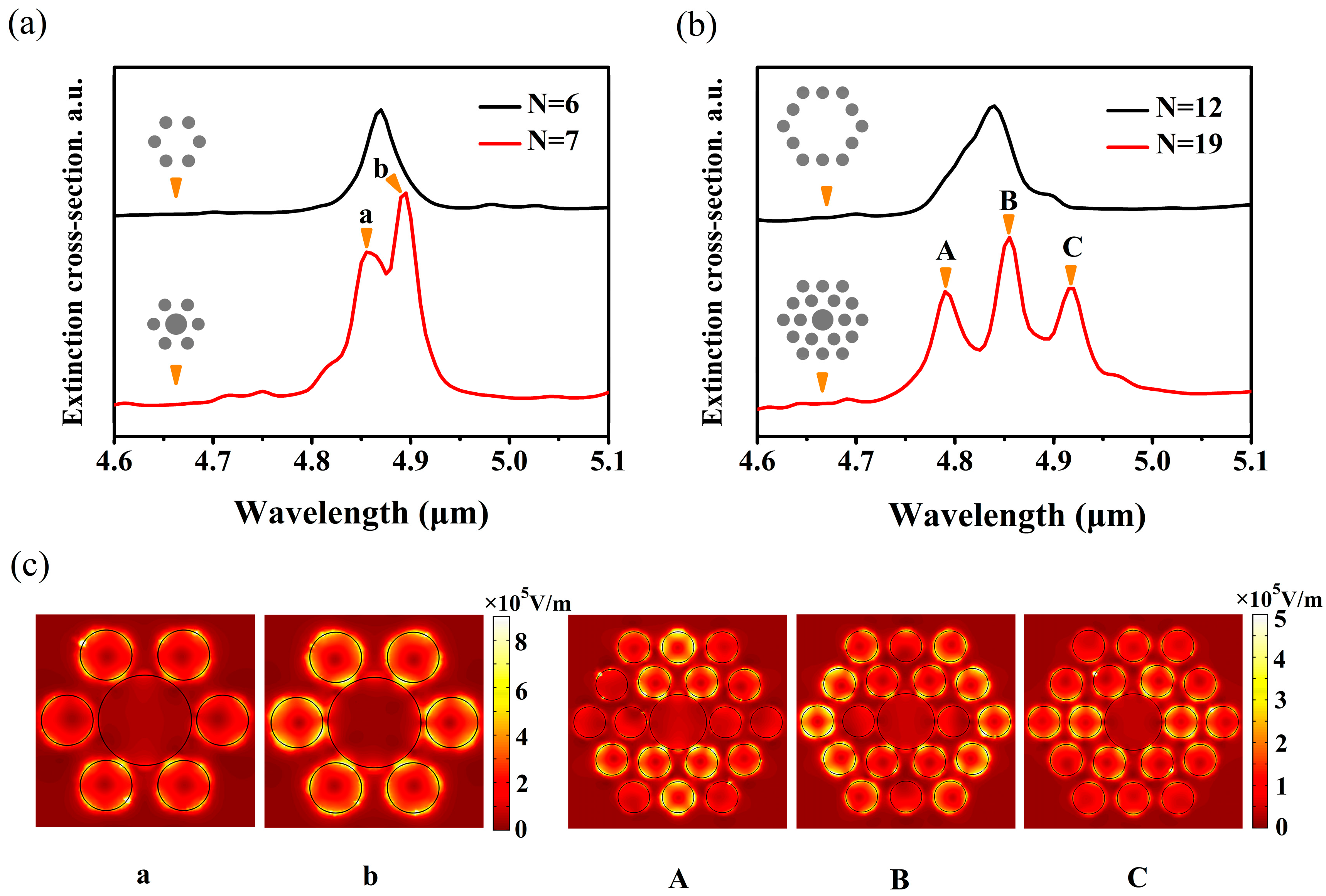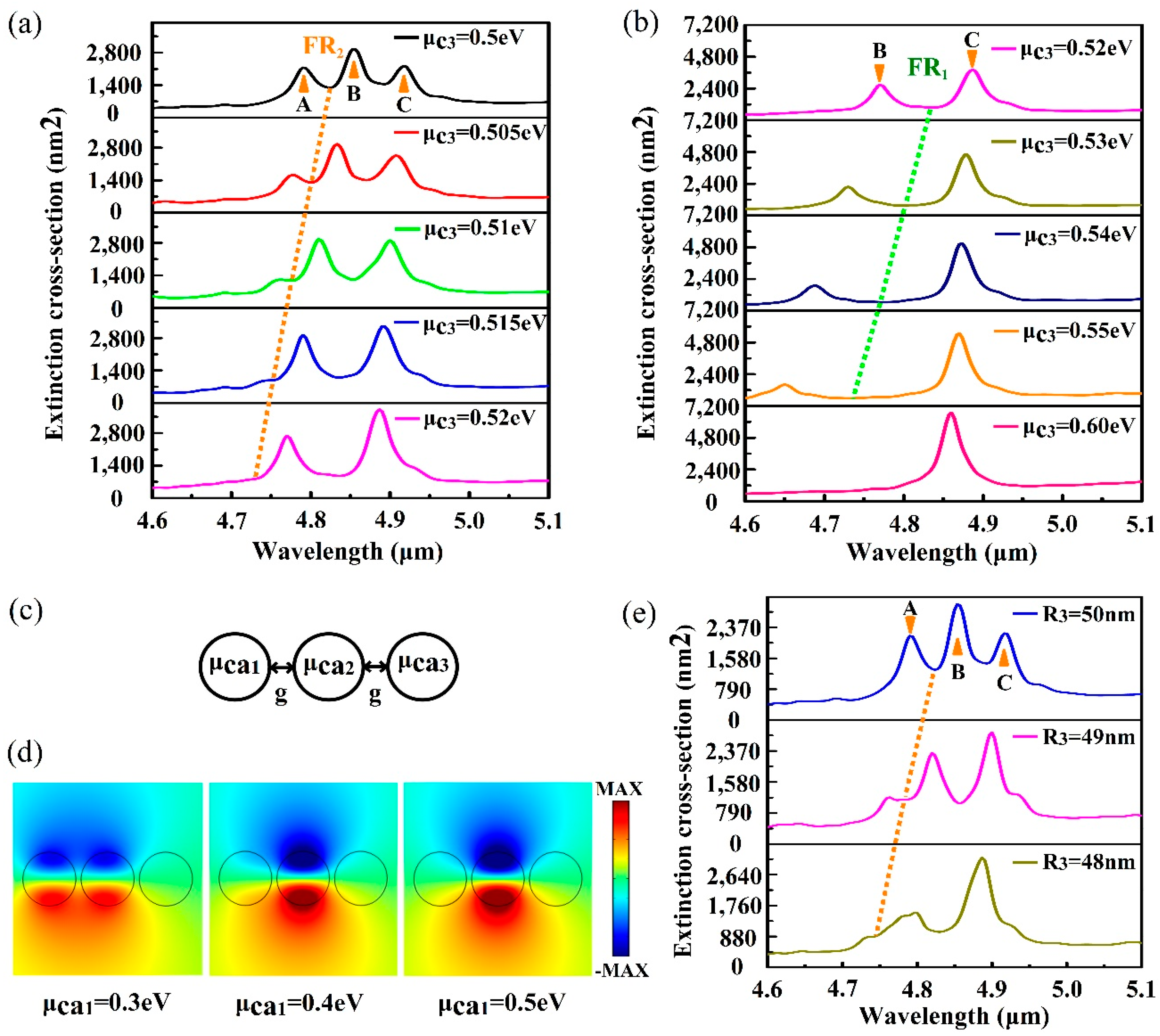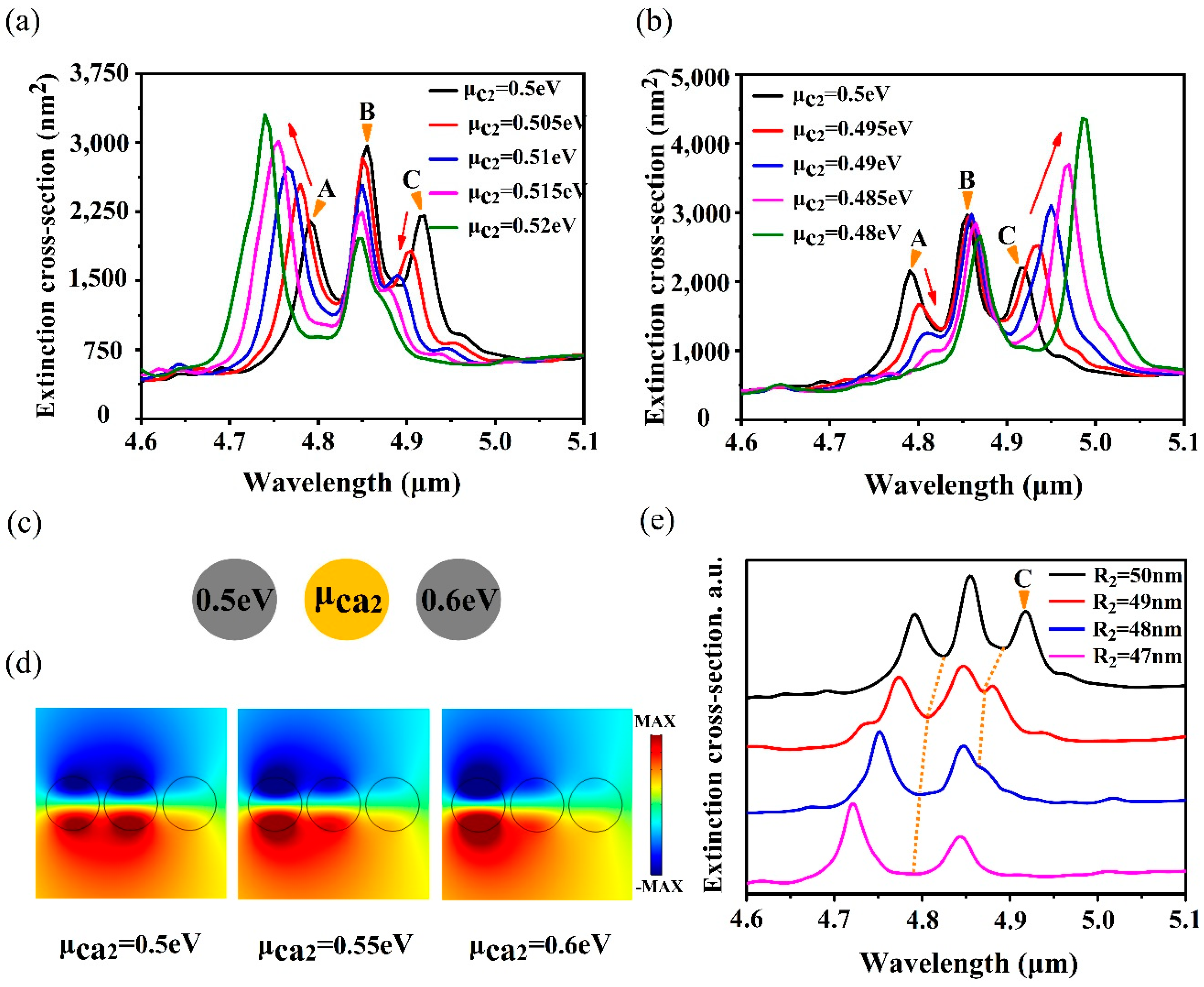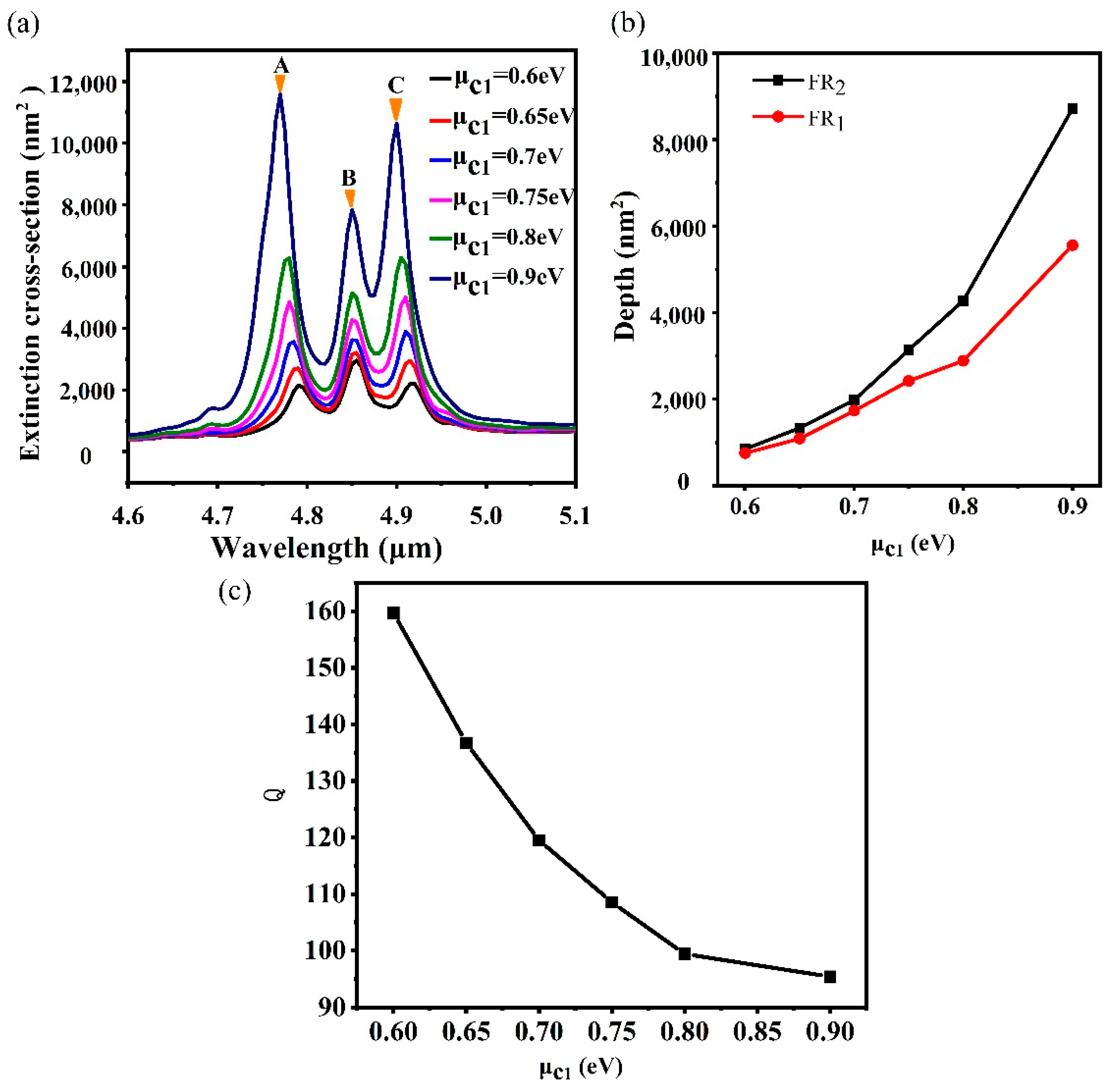Multiple Fano Resonances with Tunable Electromagnetic Properties in Graphene Plasmonic Metamolecules
Abstract
1. Introduction
2. Calculation Methods and Models
3. Results and Discussions
3.1. Fano Resonance Modes Induced by the Central Nanodisc and the Ring Nanodiscs
3.2. The Relationship between FRs and the Outer Ring Nanodiscs
3.3. The Competition between the Two FR Modes via the Intermediate Ring Nanodiscs
3.4. Modulation Depth of the Tunable FRs
4. Conclusions
Author Contributions
Funding
Conflicts of Interest
References
- Su, K.H.; Wei, Q.H.; Zhang, X.; Mock, J.; Smith, D.R.; Schultz, S. Interparticle coupling effects on plasmon resonances of nanogold particles. Nano Lett. 2003, 3, 1087–1090. [Google Scholar] [CrossRef]
- Liu, S.D.; Yang, Z.; Liu, R.P.; Li, X.Y. Multiple fano resonances in plasmonic heptamer clusters composed of split nanorings. Acs Nano 2012, 6, 6260–6271. [Google Scholar] [CrossRef] [PubMed]
- Barnes, W.L.; Dereux, A.; Ebbesen, T.W. Surface plasmon subwavelength optics. Nature 2003, 424, 824–830. [Google Scholar] [CrossRef]
- Guo, X.; Hu, H.; Zhu, X.; Yang, X.; Dai, Q. Higher order fano graphene metamaterials for nanoscale optical sensing. Nanoscale 2017, 9, 14998–15004. [Google Scholar] [CrossRef]
- Fang, Z.; Cai, J.; Yan, Z.; Nordlander, P.; Halas, N.J.; Zhu, X. Removing a wedge from a metallic nanodisk reveals a fano resonance. Nano Lett. 2011, 11, 4475–4479. [Google Scholar] [CrossRef]
- Lassiter, J.B.; Sobhani, H.; Knight, M.W.; Mielczarek, W.S.; Nordlander, P.; Halas, N.J. Designing and deconstructing the fano lineshape in plasmonic nanoclusters. Nano Lett. 2012, 12, 1058–1062. [Google Scholar] [CrossRef]
- Miroshnichenko, A.E.; Kivshar, Y.S. Fano resonances in all-dielectric oligomers. Nano Lett. 2012, 12, 6459–6463. [Google Scholar] [CrossRef]
- Zhong-Jian, Y.; Zong-Suo, Z.; Li-Hui, Z.; Qun-Qing, L.; Zhong-Hua, H.; Qu-Quan, W. Fano resonances in dipole-quadrupole plasmon coupling nanorod dimers. Opt. Lett. 2011, 36, 1542–1544. [Google Scholar]
- Liu, S.D.; Leong, E.S.P.; Li, G.C.; Hou, Y.; Deng, J.; Teng, J.H.; Ong, H.C.; Lei, D.Y. Polarization-independent multiple fano resonances in plasmonic nonamers for multimode-matching enhanced multiband second-harmonic generation. Acs Nano 2016, 10, 1442–1453. [Google Scholar] [CrossRef]
- Wu, D.; Jiang, S.; Liu, X. Tunable fano resonances in three-layered bimetallic au and Ag nanoshell. J. Phys. Chem. C 2011, 115, 23797–23801. [Google Scholar] [CrossRef]
- Mukherjee, S.; Sobhani, H.; Lassiter, J.B.; Bardhan, R.; Nordlander, P.; Halas, N.J. Fanoshells: Nanoparticles with built-in fano resonances. Nano Lett. 2010, 10, 2694–2701. [Google Scholar] [CrossRef] [PubMed]
- Verellen, N.; Van Dorpe, P.; Vercruysse, D.; Vandenbosch, G.A.; Moshchalkov, V.V. Dark and bright localized surface plasmons in nanocrosses. Opt. Express 2011, 19, 11034–11051. [Google Scholar] [CrossRef] [PubMed]
- Luk’yanchuk, B.; Zheludev, N.I.; Maier, S.A.; Halas, N.J.; Nordlander, P.; Giessen, H.; Chong, C.T. The fano resonance in plasmonic nanostructures and metamaterials. Nat. Mater. 2010, 9, 707–715. [Google Scholar] [CrossRef] [PubMed]
- Liu, N.; Langguth, L.; Weiss, T.; Kästel, J.; Fleischhauer, M.; Pfau, T.; Giessen, H. Plasmonic analogue of electromagnetically induced transparency at the drude damping limit. Nat. Mater. 2009, 8, 758–762. [Google Scholar] [CrossRef]
- Pitchappa, P.; Manjappa, M.; Ho, C.P.; Singh, R.; Singh, N.; Lee, C. Active control of electromagnetically induced transparency analog in terahertz mems metamaterial. Adv. Opt. Mater. 2016, 4, 541–547. [Google Scholar] [CrossRef]
- Fleischhauer, M.; Imamoglu, A.; Marangos, J.P. Electromagnetically induced transparency: Optics in coherent media. Rev. Mod. Phys. 2005, 77, 633. [Google Scholar] [CrossRef]
- Rahmani, M.; Lei, D.Y.; Giannini, V.; Lukiyanchuk, B.; Ranjbar, M.; Liew, T.Y.F.; Hong, M.; Maier, S.A. Subgroup decomposition of plasmonic resonances in hybrid oligomers: Modeling the resonance lineshape. Nano Lett. 2012, 12, 2101–2106. [Google Scholar] [CrossRef]
- Fedotov, V.; Papasimakis, N.; Plum, E.; Bitzer, A.; Walther, M.; Kuo, P.; Tsai, D.; Zheludev, N. Spectral collapse in ensembles of metamolecules. Phys. Rev. Lett. 2010, 104, 223901. [Google Scholar] [CrossRef]
- Hentschel, M.; Saliba, M.; Vogelgesang, R.; Giessen, H.; Alivisatos, A.P.; Liu, N. Transition from isolated to collective modes in plasmonic oligomers. Nano Lett. 2010, 10, 2721–2726. [Google Scholar] [CrossRef]
- Dayal, G.; Chin, X.Y.; Soci, C.; Singh, R. High-q whispering-gallery-mode-based plasmonic fano resonances in coupled metallic metasurfaces at near infrared frequencies. Adv. Opt. Mater. 2016, 4, 1295–1301. [Google Scholar] [CrossRef]
- Le, F.; Brandl, D.W.; Urzhumov, Y.A.; Wang, H.; Kundu, J.; Halas, N.J.; Aizpurua, J.; Nordlander, P. Metallic nanoparticle arrays: A common substrate for both surface-enhanced raman scattering and surface-enhanced infrared absorption. Acs Nano 2008, 2, 707–718. [Google Scholar] [CrossRef] [PubMed]
- Christ, A.; Martin, O.J.; Ekinci, Y.; Gippius, N.A.; Tikhodeev, S.G. Symmetry breaking in a plasmonic metamaterial at optical wavelength. Nano Lett. 2008, 8, 2171–2175. [Google Scholar] [CrossRef] [PubMed]
- Christ, A.; Ekinci, Y.; Solak, H.; Gippius, N.; Tikhodeev, S.; Martin, O. Controlling the fano interference in a plasmonic lattice. Phys. Rev. B 2007, 76, 201405. [Google Scholar] [CrossRef]
- Ren, J.; Wang, G.; Qiu, W.; Lin, Z.; Chen, H.; Qiu, P.; Wang, J.-X.; Kan, Q.; Pan, J.-Q. Optimization of the fano resonance lineshape based on graphene plasmonic hexamer in mid-infrared frequencies. Nanomaterials 2017, 7, 238. [Google Scholar] [CrossRef]
- Khan, A.D. Multiple fano resonances in bimetallic layered nanostructures. Int Nano Lett 2014, 4, 1–12. [Google Scholar] [CrossRef]
- Fu, Y.H.; Zhang, J.B.; Yu, Y.F.; Luk’Yanchuk, B. Generating and manipulating higher order fano resonances in dual-disk ring plasmonic nanostructures. Acs Nano 2012, 6, 5130–5137. [Google Scholar] [CrossRef]
- Liu, S.D.; Yang, Y.-B.; Chen, Z.-H.; Wang, W.-J.; Fei, H.-M.; Zhang, M.-J.; Wang, Y.-C. Excitation of multiple fano resonances in plasmonic clusters with d 2 h point group symmetry. J. Phys. Chem. C 2013, 117, 14218–14228. [Google Scholar] [CrossRef]
- Ren, J.; Qiu, W.; Chen, H.; Qiu, P.; Lin, Z.; Wang, J.X.; Kan, Q.; Pan, J.-Q. Electromagnetic field coupling characteristics in graphene plasmonic oligomers: From isolated to collective modes. Phys. Chem. Chem. Phys. 2017, 19, 14671–14679. [Google Scholar] [CrossRef]
- Ren, J.; Wang, W.; Qiu, W.; Qiu, P.; Wang, Z.; Lin, Z.; Wang, J.-X.; Kan, Q.; Pan, J.-Q. Dynamic tailoring of electromagnetic behaviors of graphene plasmonic oligomers by local chemical potential. Phys. Chem. Chem. Phys. 2018, 20, 16695–16703. [Google Scholar] [CrossRef]
- Vakil, A.; Engheta, N. Transformation optics using graphene. Science 2011, 332, 1291–1294. [Google Scholar] [CrossRef]
- Zhang, Y.; Zhen, Y.-R.; Neumann, O.; Day, J.K.; Nordlander, P.; Halas, N.J. Coherent anti-stokes raman scattering with single-molecule sensitivity using a plasmonic fano resonance. Nat. Commun. 2014, 5, 4424. [Google Scholar] [CrossRef] [PubMed]
- Zhan, Y.; Lei, D.Y.; Li, X.; Maier, S.A. Plasmonic fano resonances in nanohole quadrumers for ultra-sensitive refractive index sensing. Nanoscale 2014, 6, 4705–4715. [Google Scholar] [CrossRef] [PubMed]
- Hao, F.; Nordlander, P.; Sonnefraud, Y.; Dorpe, P.V.; Maier, S.A. Tunability of subradiant dipolar and fano-type plasmon resonances in metallic ring/disk cavities: Implications for nanoscale optical sensing. Acs Nano 2009, 3, 643–652. [Google Scholar] [CrossRef] [PubMed]
- Woessner, A.; Lundeberg, M.B.; Gao, Y.; Principi, A.; Alonso-González, P.; Carrega, M.; Watanabe, K.; Taniguchi, T.; Vignale, G.; Polini, M. Highly confined low-loss plasmons in graphene–boron nitride heterostructures. Nat. Mater. 2015, 14, 421–425. [Google Scholar] [CrossRef]
- Chen, J.; Badioli, M.; Alonso-González, P.; Thongrattanasiri, S.; Huth, F.; Osmond, J.; Spasenović, M.; Centeno, A.; Pesquera, A.; Godignon, P. Optical nano-imaging of gate-tunable graphene plasmons. Nature 2012, 487, 77. [Google Scholar] [CrossRef]
- Nikitin, A.Y.; Guinea, F.; Garcia-Vidal, F.J.; Martin-Moreno, L. Surface plasmon enhanced absorption and suppressed transmission in periodic arrays of graphene ribbons. Phys. Rev. B 2012, 85, 081405. [Google Scholar] [CrossRef]
- Liu, R.; Liao, B.; Guo, X.; Hu, D.; Hu, H.; Du, L.; Yu, H.; Zhang, G.; Yang, X.; Dai, Q. Study of graphene plasmons in graphene–mos 2 heterostructures for optoelectronic integrated devices. Nanoscale 2017, 9, 208–215. [Google Scholar] [CrossRef]
- Bao, Q.; Zhang, H.; Wang, B.; Ni, Z.; Lim, C.H.Y.X.; Wang, Y.; Tang, D.Y.; Loh, K.P. Broadband graphene polarizer. Nat. Photonics 2011, 5, 411–415. [Google Scholar] [CrossRef]
- Tymchenko, M.; Nikitin, A.Y.; Martin-Moreno, L. Faraday rotation due to excitation of magnetoplasmons in graphene microribbons. Acs Nano 2013, 7, 9780–9787. [Google Scholar] [CrossRef]
- Liu, M.; Yin, X.; Ulin-Avila, E.; Geng, B.; Zentgraf, T.; Ju, L.; Wang, F.; Zhang, X. A graphene-based broadband optical modulator. Nature 2011, 474, 64–67. [Google Scholar] [CrossRef]
- Sun, Z.; Martinez, A.; Wang, F. Optical modulators with 2d layered materials. Nat. Photonics 2016, 10, 227–238. [Google Scholar] [CrossRef]
- Hu, H.; Yang, X.; Zhai, F.; Hu, D.; Liu, R.; Liu, K.; Sun, Z.; Dai, Q. Far-field nanoscale infrared spectroscopy of vibrational fingerprints of molecules with graphene plasmons. Nat. Commun. 2016, 7, 12334. [Google Scholar] [CrossRef] [PubMed]
- Britnell, L.; Ribeiro, R.; Eckmann, A.; Jalil, R.; Belle, B.; Mishchenko, A.; Kim, Y.-J.; Gorbachev, R.; Georgiou, T.; Morozov, S. Strong light-matter interactions in heterostructures of atomically thin films. Science 2013, 340, 1311–1314. [Google Scholar] [CrossRef] [PubMed]
- Grigorenko, A.; Polini, M.; Novoselov, K. Graphene plasmonics. Nat. Photonics 2012, 6, 749–758. [Google Scholar] [CrossRef]
- Low, T.; Avouris, P. Graphene plasmonics for terahertz to mid-infrared applications. Acs Nano 2014, 8, 1086–1101. [Google Scholar] [CrossRef]
- Rodrigo, D.; Limaj, O.; Janner, D.; Etezadi, D.; De Abajo, F.J.G.; Pruneri, V.; Altug, H. Mid-infrared plasmonic biosensing with graphene. Science 2015, 349, 165–168. [Google Scholar] [CrossRef]
- Brar, V.W.; Jang, M.S.; Sherrott, M.; Kim, S.; Lopez, J.J.; Kim, L.B.; Choi, M.; Atwater, H. Hybrid surface-phonon-plasmon polariton modes in graphene/monolayer h-bn heterostructures. Nano Lett. 2014, 14, 3876–3880. [Google Scholar] [CrossRef]
- Yan, H.; Low, T.; Zhu, W.; Wu, Y.; Freitag, M.; Li, X.; Guinea, F.; Avouris, P.; Xia, F. Damping pathways of mid-infrared plasmons in graphene nanostructures. Nat. Photonics 2013, 7, 394–399. [Google Scholar] [CrossRef]
- Zhang, Q.; Wen, X.; Li, G.; Ruan, Q.; Wang, J.; Xiong, Q. Multiple magnetic mode-based fano resonance in split-ring resonator/disk nanocavities. Acs Nano 2013, 7, 11071–11078. [Google Scholar] [CrossRef]
- He, X.; Lin, F.; Liu, F.; Shi, W. Terahertz tunable graphene fano resonance. Nanotechnology 2016, 27, 485202. [Google Scholar] [CrossRef]
- Dregely, D.; Hentschel, M.; Giessen, H. Excitation and tuning of higher-order fano resonances in plasmonic oligomer clusters. Acs Nano 2011, 5, 8202–8211. [Google Scholar] [CrossRef] [PubMed]
- Chen, P.-Y.; Alu, A. Atomically thin surface cloak using graphene monolayers. Acs Nano 2011, 5, 5855–5863. [Google Scholar] [CrossRef] [PubMed]
- Li, Z.Q.; Henriksen, E.A.; Jiang, Z.; Hao, Z.; Martin, M.C.; Kim, P.; Stormer, H.L.; Basov, D.N. Dirac charge dynamics in graphene by infrared spectroscopy. Nat. Phys. 2008, 4, 532–535. [Google Scholar] [CrossRef]
- Falk, A.L.; Chiu, K.-C.; Farmer, D.B.; Cao, Q.; Tersoff, J.; Lee, Y.-H.; Avouris, P.; Han, S.-J. Coherent plasmon and phonon-plasmon resonances in carbon nanotubes. Phys. Rev. Lett. 2017, 118, 257401. [Google Scholar] [CrossRef] [PubMed]
- Palik, E.D. Handbook of Optical Constants of Solids; Academic Press: San Diego, CA, USA, 1998; Volume 3. [Google Scholar]
- Mario, H.; Daniel, D.; Ralf, V.; Harald, G.; Na, L. Plasmonic oligomers: The role of individual particles in collective behavior. Acs Nano 2011, 5, 2042. [Google Scholar]
- Shen, Y.; Zhou, J.; Liu, T.; Tao, Y.; Jiang, R.; Liu, M.; Xiao, G.; Zhu, J.; Zhou, Z.-K.; Wang, X. Plasmonic gold mushroom arrays with refractive index sensing figures of merit approaching the theoretical limit. Nat. Commun. 2013, 4, 2381. [Google Scholar] [CrossRef]





© 2020 by the authors. Licensee MDPI, Basel, Switzerland. This article is an open access article distributed under the terms and conditions of the Creative Commons Attribution (CC BY) license (http://creativecommons.org/licenses/by/4.0/).
Share and Cite
Zhou, H.; Su, S.; Qiu, W.; Zhao, Z.; Lin, Z.; Qiu, P.; Kan, Q. Multiple Fano Resonances with Tunable Electromagnetic Properties in Graphene Plasmonic Metamolecules. Nanomaterials 2020, 10, 236. https://doi.org/10.3390/nano10020236
Zhou H, Su S, Qiu W, Zhao Z, Lin Z, Qiu P, Kan Q. Multiple Fano Resonances with Tunable Electromagnetic Properties in Graphene Plasmonic Metamolecules. Nanomaterials. 2020; 10(2):236. https://doi.org/10.3390/nano10020236
Chicago/Turabian StyleZhou, Hengjie, Shaojian Su, Weibin Qiu, Zeyang Zhao, Zhili Lin, Pingping Qiu, and Qiang Kan. 2020. "Multiple Fano Resonances with Tunable Electromagnetic Properties in Graphene Plasmonic Metamolecules" Nanomaterials 10, no. 2: 236. https://doi.org/10.3390/nano10020236
APA StyleZhou, H., Su, S., Qiu, W., Zhao, Z., Lin, Z., Qiu, P., & Kan, Q. (2020). Multiple Fano Resonances with Tunable Electromagnetic Properties in Graphene Plasmonic Metamolecules. Nanomaterials, 10(2), 236. https://doi.org/10.3390/nano10020236







